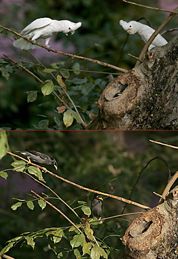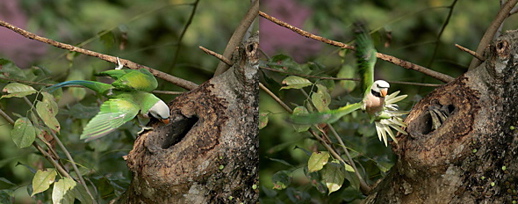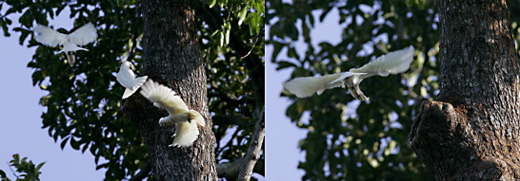The trees around Changi where the Oriental Pied Hornbills (Anthracoceros albirostris) were nesting are also roosting and nesting sites of other birds (1, 2, 3, 4, 5, 6, 7). The cavities used by the hornbills are similarly sought after by Tanimbar Corella (Cacatua goffini), Long-tailed Parakeet (Psittacula longicauda) and Red-breasted Parakeet (P. alexandri). These are competitors for the limited nesting cavities available in urban Singapore.
Over at the angsana tree (Pterocarpus indicus) the nesting hornbills were regularly harassed by Tanimbar Corellas (left top) and Javan Mynas (Acridotheres javanicus) (left bottom). The former were loud, noisy, and aggressive birds. A few times one or two pairs of corellas came to the hornbills’ nests to check. They were always curious, sliding cautiously, nearer and nearer to the nest on a nearby branch. The female sealed inside, at times poked her beak out of the opening to counter the curious birds when one got too near for comfort. Invariably, this gave them a fright. Once, the male hornbill suddenly appeared, frightening the corellas away. There was a time when the corellas tried to mob the hornbill but without success. The mynas were not as aggressive but curious just the same.
The same thing happened with the Red-breasted Parakeet that came too close to the cavity (above). The female hornbill was in the process of sealing herself in but stopped working to counter the intrusion, poking her beak out of the nest opening.
Over at the shorea nest the situation was just the same. The noisy corellas were just as curious. And there were more of the troublesome birds (above).
Melinda Chan & YC Wee
Singapore
June 2007
(Images by Chan Yoke Meng)











